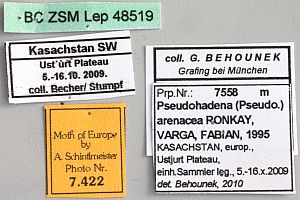3. Weitere Informationen
3.1. Etymologie (Namenserklärung)
Ronkay, Varga & Fábián (1995: 260): “Etymologie: the specific name refers to the sandy ochreous-greyish colouration of the forewings.”
3.2. Faunistik
In Europa Nachweis eines einzelnen Männchens im September 2002 im südlichen Ural bei Verbljushka; die Art war bis dahin nur vom Typenfundort 2000 km entfernt in Südosten von Kasachstan bekannt (Fibiger & Hacker 2007). Der später gefunden (und oben gezeigte) Beleg aus dem Ustjurt-Plateau gehört zwar in den Westen Kasachstans, jedoch ebenfalls in dessen asiatischen Teil. Anikin et al. (2017: 275) kennen keinen weiteren Beleg aus dem Wolga-Ural-Gebiet, weshalb wir den Nachweis im Südural im Lepiforum vorerst als Einzelnachweis für Russland und damit auch Europa werten.
(Autor: Erwin Rennwald)
3.3. Typenmaterial
Ronkay, Varga & Fábián (1995: 258): “Holotype: male, “Kazakhstan, Prov. Almaty, 22 km N of Masak, 600 m, 78°27'E, 43°46'N, 27.IX. 1994, leg. Gy. Fábián & Gy. M. László”, coll. Gy. Fábián, Budapest, deposited in HNHM Budapest.
Paratypes: 14 males from the same locality and data, coll. HNHM Budapest, Gy. Gábián, G. Ronkay & Z. Varga.
Slide No. 4937 Ronkay.”
3.4. Literatur
- Anikin, V.V., Sachkov, S.A. & V.V. Zolotuhin (2017): "Fauna lepidopterologica Volgo-Uralensis": from P. Pallas to present days. — Proceedings of the Museum Witt Munich, Volume 7: 1-696; Munich and Vilnius.
- Fibiger, M. & H. Hacker (2007): Noctuidae Europaeae. Volume 9. Amphipyrinae, Condicinae, Eriopinae, Xyleninae (part). — 410 S., 12 Farbtafeln; Sorø (Entomological Press).
- Erstbeschreibung: Ronkay, L., Varga, Z. & G. Fábián (1995): Taxonomic studies on the genus Pseudohadena Alphéraky, 1889. Part V. The revision of the genus Pseudohadena s. str. — Acta Zoologica Academiae Scientiarum Hungaricae 41 (3): 253-284. [Digitalisat auf archive.org]




![Einzelnachweis in Russland (europäischer Teil bis Manytsch-Niederung) [Fibiger & Hacker 2007]](/res/img/flag/ru.gif)




